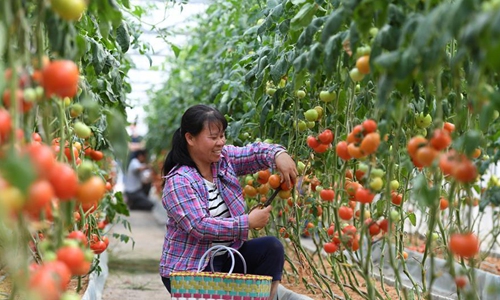
A farmer picks tomatoes in a greenhouse at Tangwan Village of Chuanshan Town in Huanjiang Maonan Autonomous County, south China's Guangxi Zhuang Autonomous Region, May 12, 2020. In recent years, the autonomous county has stressed the development of collective economies in its villages, such as rural greenhouse economy, to help improve locals' incomes. (Xinhua/Lu Boan)
A group of figures stood out from Chinese Premier Li Keqiang's remarks at an annual press conference on Thursday as offering a sobering reminder of challenges to prop up the economy amid the raging pandemic.
The rare mention indicates the government's focus on average folk wellbeing that has inevitably taken a hit from the virus onslaught, analysts said, expecting the eye-catching numbers to be translated into massive growth opportunities for the world's largest developing nation.
China is a populous developing nation with an average per capita income of 30,000 yuan ($4,196.33) per annum, but 600 million people have a monthly income of only 1,000 yuan. With 1,000 yuan, it might be difficult to rent a home in a mid-sized city, which is now compounded by the coronavirus outbreak, the premier told reporters, noting that people's livelihood is of utmost significance post-COVID-19.
The figures have been making the rounds on Chinese social media, with many web users voicing their amazement at the monthly income reading for over 40 percent of the nation's population.
The total population on the Chinese mainland topped 1.4 billion at the end of 2019, according to official data.
The statistical formula for the reading remains unclear and it's likely that the poorer part of the population mainly consists of self-sustaining rural dwellers and residents of remote small towns in the central and western parts of the country, according to an economist in Shanghai speaking on condition of anonymity.
China's rural population as a percentage of total population fell to 40.42 percent in 2018 from 89.36 percent in 1949, according to the National Bureau Statistics (NBS). This means the nation's current rural population is less than 600 million.
The reading is supposed to be the per capita income of mostly rural dwellers, as dependent people as a percentage of the workforce is normally much higher in rural China than in urban areas, Bai Ming, a senior research fellow at the Chinese Academy of International Trade and Economic Cooperation, told the Global Times on Friday.
It's also the case that self-sufficient living prevalent among rural dwellers cuts their reliance on cash income, Bai said.
Per capita disposable income of rural residents in the nation's poverty-stricken areas grew 11.5 percent in nominal terms to 11,567 yuan in 2019, NBS data showed. That suggests a monthly per capita disposable income of less than 1,000 yuan.
As part of efforts to ensure that China can hit a two-pronged crucial wellbeing milestone this year - eliminating absolute poverty and building a moderately prosperous society in all aspects - the premier disclosed Thursday that an extra 2 million people will be covered in the nation's subsistence allowance, unemployment insurance, and assistance for the extremely poor this year. The yearly coverage affects about 60 million people.
Additionally, sufficient fiscal, monetary and social security policy support from the government, as pledged by the premier, lays the groundwork for the economy to achieve positive growth this year, thereby cementing belief in the nation to declare moderate prosperity this year.
The figures also serve as a wake-up call for the nation's wealth gap, the experts said, calling for efforts to explore new sources of income for the poorer part of the country while making taxation more efficient to create a fairer society.
Findings of a survey in October 2019 of more than 30,000 urban households across the country by the survey and statistics department of the People's Bank of China (PBC), China's central bank, were revealed in late April.
The surveyed households recorded 2.89 million yuan on average in net assets while the median net worth stood at 1.41 million yuan. Assets held by urban households comprise mostly of in-kind assets, averaging 2.53 million yuan, or 80 percent of total household assets. Furthermore, 74.2 percent of in-kind asset were found to be property assets, with per capita housing assets hitting 1.88 million yuan.
Beijing, Shanghai, and East China's Jiangsu Province were the top three on the household assets ranking. Total assets owned by families in Beijing average 8.93 million yuan.
What's inspiring, though, from the 600 million reading, as the Shanghai-based economist, put it, is this part of the population would turn out to be a thriving force powering the economic growth in years to come.
The drive for urbanization and new tech infrastructure that would reshape rural China means much of the 600 million people would see a marked increased in their income, as the resultant investment in transport and other facilities is set to create more streams of income, he said, adding that the current low base suggests enormous growth potential down the road that would see an addition of 600 million affluent customers sometime in the future.
Global Times




